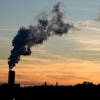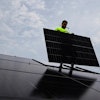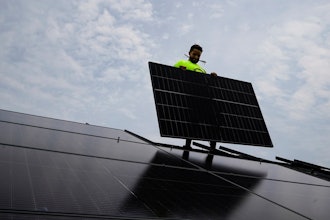Wausau, WI-based Linetec is an architectural finishing company that takes seriously its delicate relationship with its state’s natural beauty. The company, founded in 1983, has consistently and eagerly moved toward reducing its environmental impact through dozens of projects, both small and large, which has led to reductions in VOCs, waste, excess heat, and energy — not to mention dollars spent on daily operations.
The company’s primary operations, high-performance metal finishing, involves painting, anodizing, and powder-coating both large and small aluminum parts to be used in architectural installations. And the standards for quality — what Linetec president Rick Marshall means when he describes his business as “high-performance” — are staggering. He says, “People think of automotive as high-performance, but if you leave your car out in the sunshine, you’ll see a difference in the coating. In architectural, [finishes go] on buildings that are 40 or 50 stories tall and are expected to last 40 to 50 years. It’s about as high-performance as high-performance can get.”
The chemicals vital to Linetec’s business are not kind to the environment, but that has only further encouraged Marshall’s emphasis on environmental stewardship. When Marshall came in to helm the company more than a decade ago, he established 11 “Core Values,” which include environmental responsibility. Jon Close, Vice President of Sales and Marketing, says these values are not “just words on a wall. People see the company doesn’t just preach it, but live it.” The local forests, prairies and farmland that surround the multi-facility complex a few miles west of downtown Wausau live it, too — they are, in all respects, in the immaculate condition that Wisconsinites love and expect out of their state.
And those efforts haven’t gone unnoticed. In 2006, the company was given a Wisconsin Manufacturer of the Year Grand Award for overall outstanding achievement in the category of a “large company” (300-999 employees). In 2011, the company was honored with another Wisconsin Manufacturer of the Year award, this time in the sustainability category.
Tammy Schroeder, a Linetec senior marketing specialist and a LEED® Green Associate, was tasked with compiling data on all of Linetec’s environmental improvements over the last three decades, which she likened to writing a novel. Most of the changes — and the overall significance of Linetec’s innovation — were small-scale projects focused on a specific inefficiency. Close agrees: “Being a job shop, I think you’ll see a lot of that sustainability message come through from the very, very small things. You’ll look at it and think, ‘That can’t make that big of a deal,’ but a lot of small things add up to some big things.”
No More Wasted Heat
One of Linetec’s most recent environmental investments is its Anodize Scrubber Heat Capture project, which captures waste heat and uses it to keep the plant floor warm during cold Wisconsin winters. The project was completed in February 2011, but the genesis for this investment began more than a decade ago, when Linetec’s management recognized the enormous amount of energy that was exhausted out of the anodize facility. According to Schroeder, 60,000 cubic feet of 62 degree F air was being exhausted outside the plant every minute.
The company had actually atempted to solve this issue by redirecting warm waste heat back into the facility straight from its scrubber units, but that drastically increased the level of humidity in the plant — Schroeder says many surfaces were actually collecting condensation from the high dew point. The redirection was scrapped, but Linetec’s Energy Management Team took another year to conduct the necessary research and development on a method to process the air so that it could be recycled at a more comfortable humidity.
In early 2011, the company invested more than $275,000 to enhance the intake of the facility’s air make-up unit with a radiator and copper coil. This system uses cold Wisconsin air to cool the water that moves through the coil, better scrubbing the air while reducing the dew point of the exhaust air. Because of this change, Linetec was once again able to pull this processed air back into its facility, reducing energy needs.
And the benefits have been numerous, and surprising in effectiveness. The system saved an annual average of 114,000 therms in 2011, which is equivalent to more than 70 Wisconsin homes. It’s also equated to a $57,000 annual reduction in energy costs, which aligns well with Linetec’s goals of protecting the environment while making smart investments that increase the operational efficiency of their facilities. In fact, the company says their system of reclaiming exhaust heat by lowering dew points is the only such process currently active in the U.S.
Painting Gets Smarter
As one of the pillars of Linetec’s business, the painting line has received a good deal of attention from the company’s management in the search for more efficient and environmentally-friendly processes. The company has enacted more than a dozen environmental innovations onto the painting process in the last three decades, which have reduced the exhaust of VOCs and slashed energy usage while saving the company hundreds of thousands of dollars in operational expenses.
Like many American manufacturers, Linetec has incorporated automation into its painting lines, using an array of industrial robots to apply a variety of primers and topcoat paints. The robots are able to adjust their movements on-the-fly, based on the shape of each piece being fed through the production line. This allows them to spray only where it’s needed, eliminating excess. The paint, which is atomized as it passes through the robot’s painting nozzle, is electrostatically attracted to the parts, which further minimizes the paint volume needed to finish the job.
And it’s clear, when one peeks into the paint booths, that waste has been minimized to an extraordinary degree — the walls and floor are surprisingly devoid of wasted paint. The robots are outfitted with plastic covers to keep their sensitive mechanisms free of chemicals, but one gets the impression they might not even be necessary.
The efficiency of this robotic painting system wouldn’t be possible without some improvements in the adjacent room, where paint is mixed from base colors into the custom color of the customer’s preference, which Linetec can match from just about any source thanks to some sophisticated spectrophotometers. For nearly three decades, paint was mixed by hand in drums of various sizes, and employees weighed each amount of paint on scales in preparing the final mixture. This process worked, but it led to a good deal of wasted paint and excess labor.
The automatic paint dispensing system is a surprisingly complex network of tubes, valves, and drums of paint that connect to a centralized mixing unit. Employees load the necessary colors into the dispensing equipment, and the system takes care of the rest. Close says this system has greatly reduced the time needed to load up a mixed paint while making the process safer for employees. Because the computers use highly-sensitive sensors to ensure the quality of each batch, there’s little need to rework paint, and scrap rates have fallen.
Schroeder says Linetec has saved 1,200 gallons of paint from being needlessly produced since the system went online, which has reduced the necessary storage space for waste product. She adds that because of the various efficiencies and waste removals, the automatic paint dispensing system has made significant savings for the company. Perhaps more importantly, it has reduced the amount of waste being sent to the landfill, and creates less VOCs.
It’s In The Little Things
While Linetec might not be shy in making significant capital investments, dozens of smaller projects combine to create the accumulation that Close mentioned. Replacing a majority of that wasteful packaging are reusable steel racks that guide most product through its life on the Linetec plant floor. To reduce the amount of waste packaging that enters through the loading dock, Linetec has inked deals with customers of all sizes to load their parts onto Linetec’s reusable racks instead of boxing them up in cardboard. This saves everyone time and money, makes their integration tighter and, according to Schroeder, has eliminated 650,000 pounds of plastic, wood, and cardboard from Linetec’s waste stream.
In 2009, Linetec took a hard look at its anodizing process, which involves caustic chemicals to change the actual atomic structure of the part’s exterior, otherwise known as “etching.” Those chemicals had been standardized decades ago, but in 2009, Linetec unveiled a new etching chemistry, which reduces landfill waste by 70 percent. Since then, the changes have trickled down to almost every aspect of the process. The new chemistry conceals small defects and scratches in aluminum, which reduces scrap, and produces recyclable byproducts. Perhaps most importantly, the new process allows Linetec to anodize parts made of recycled aluminum, which was not possible using the traditional chemicals.
The Impact, Or Lack Thereof
Dig into Linetec’s legacy of environmental stewardship and one will find a stunning overall achievement, one that’s almost impossible to accurately gauge. The company has saved millions of tons of waste — everything from plastic to chemical byproducts and paint — from reaching local landfills. Their energy efficiency projects, which include more efficient lighting, compressor optimizations, and heat reclamation processes, have pulled millions of kilowatt-hours off Wisconsin’s electrical grid and significantly reduced the need for natural gas.
Schroeder’s hard work in cataloguing Linetec’s environmental improvements has lead to some staggering numbers. The Anodize Scrubber Heat Capture project, along with other innovations, have reduced greenhouse gases by 23.4 percent, while a project to reduce water consumption in anodizing cut usage by 49.8 percent. The new anodizing etch chemistry helped Linetec reduce solid waste by a staggering 64.9 percent.
Perhaps most fascinating about Linetec’s achievements is when they have decided to invest in some of their biggest projects — the company has made more than 15 significant investments since the beginning of 2009. Nonetheless, the company’s executives and managers are confident that their long history of investment is precisely why the company is still able to compete in gloomy times. Operational efficiencies have reduced month-to-month expenses, while a sustainable mission helped retain and attract new customers.
So far, Linetec’s efforts can be seen on well-known buildings like the MIT Media Lab, the 96th Street subway station in New York City, the hurricane-proof Houston Galleria, and many more. These buildings are often ultra-modern and LEED-certified, designed to blend into the local environment while simultaneously making an architectural statement. In a sense, Linetec’s own innovations and philosophies are spread around the country with the construction of each new façade, and every destination — particularly Wausau, Wisconsin — is made better by their hard work and innovation.























